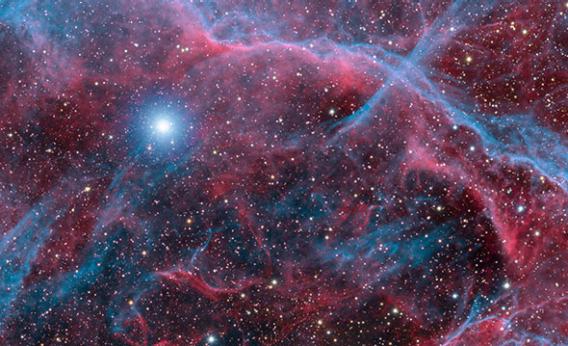Create a free profile to get unlimited access to exclusive videos, sweepstakes, and more!
Now THAT’S a Supernova

The problem with supernova remnants is that so many of them just don’t look like explosions.
They’re round circles, or disks, or this, or that, (or Ben Grimm, or a blastocyte), but at a glance they don’t convey the awesome magnitude of a supernova, the most catastrophic event the Universe can provide. At the end of its life, a massive star explodes, literally tearing itself to shreds, blasting octillions of tons of matter outwards at a healthy fraction of the speed of light. At peak brightness, they can outshine the Sun by a factor of a billion.
So yeah. They should look like explosions.
One of the very few that does is the Vela supernova remnant, the debris from a star that blew its lid roughly 11,000 years ago. It’s not exactly clear how far way it is, but it’s something like 800 light-years distant. It’s huge, covering a full 8° of sky, more than 15 times wider than the full Moon.
And it looks like this:
Holy yikes. See? Kaboom.
This image was taken by astrophotographer Marco Lorenzi. It took him many weeks to collect a total of 66 hours of observing data, comprising more than 50 million pixels in a four-panel mosaic. He used a TEC APO 140 telescope, if you’re curious, a very, very nice instrument indeed. It’s located at the Warrumbungle Observatory in Coonabarabran, Australia (the constellation of Vela is in the south, and best seen from the Southern Hemisphere).
He used five filters to make it: a trio of red, green, and blue to approximate the color the stars appear to the eye, plus two filters that isolate light from hydrogen (shown as red) and oxygen (blue), which both glow merrily in supernovae remnants.
The filaments you see are the wreckage from the star’s explosion. They’re actually a mix of the star debris plus material from between the stars, plowed up by the rapidly expanding supernova gas. This causes the supernova gas to compress, break up, and form those long tendrils.
Even this magnificent picture is only a piece of the supernova remnant; in 2011 Lorenzi made a wider-field image of it and you can see it more in context. It’s magnificent. You should also peruse his other nebula pictures, because your brain will thank you.
Supernovae are terrifying. But they’re also important; we literally owe our existence to them. They create heavy elements in the blast, then fling them for dozens of light-years around. This can then seed other clouds of gas, which then make stars, planets … and you. Nearly every element in the Universe other than hydrogen and helium was forged in the heart of an exploding star like the one that created the Vela nebula, including the iron in your blood and the phosphorus in your DNA.
So when you look on this picture, you’re seeing death and destruction on a soul-crushing scale, but you’re also seeing the factory in which the ingredients of life itself are made.
The Universe is many things, but when it uses the death of a star to create the elements for life, it’s literally ironic.


























